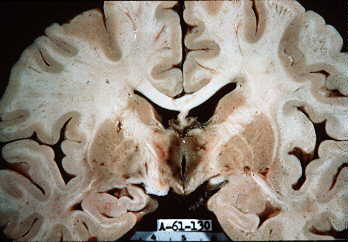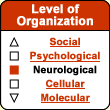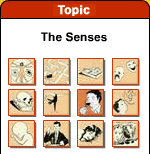|
|


| People who consume alcohol
to the point of acute intoxication can experience “blackout” episodes:
periods in which they engage in conversations and perform tasks,
but of which they have no memory once they have sobered up.
Contrary to what was previously believed, their problem is
not in retrieving the memories, but rather in having failed
to store them in the first place. Sedatives such as barbiturates
and benzodiazepines can
also produce this kind of amnesia. |
|
|
| LESIONS THAT CAUSE
AMNESIA |
|
The various
types of memory involve various structures in the brain,
and their destruction causes differing amnesic syndromes.
The best known of these is the global
amnesic syndrome experienced by patient
H.M., which was characterized by severe
anterograde amnesia and more moderate retrograde amnesia.
This syndrome results from bilateral lesions of the medial portion
of the temporal lobe, and more specifically, of the hippocampus
and its neighbouring structures (the parahippocampal, entorhinal,
and perirhinal cortexes). These lesions can be due to surgical
ablation, as in the case of H.M., or to other causes such as
tumours, ischemic episodes, head traumas, and various forms of
encephalitis.
Another well-known form of amnesia is Korsakoff’s
syndrome, encountered for the first time in chronic
alcoholics. Korsakoff’s syndrome is similar to global
amnesic syndrome, except that people with Korsakoff’s
are more prone to confabulation to cover up gaps in their memories
of their own past. Korsakoff’s syndrome is also known
as diencephalic amnesia, because the vitamin B1 deficiency
that results from alcoholism causes bilateral damage to the
mammillary bodies of the hypothalamus. Similar symptoms are
also produced by damage to the dorsomedial thalamic nuclei,
the mammillothalamic tract, and the upper portion of the brainstem.
Once again, other etiologies, such as strokes and tumours,
can affect the same structures and produce the same results.

Brain affected by Wernicke-Korsakoff
syndrome.
Note the pigmentation of the grey matter around the third ventricle.
Source: University of Texas (Houston)
There is also an amnesia of the frontal
lobe due to damage at this site. People with this disorder
do not suffer from global amnesia, but do show a memory deficit
in tasks involving temporal planning of sequences of events.
These people also have problems with the sources of newly acquired
knowledge and have deficient meta-memory (they cannot make judgments
about their memory’s contents).
Other types of damage to the cortex can cause
forms of amnesia that are sometimes highly specific. For
example, if the part of the cortex that perceives colours is damaged,
people can lose their knowledge of colour. And since the memory
of colours is reconstructed at this same location, this memory
disappears as well.
A specific injury to the amygdala can
prevent people from recording memories of traumatic events. In
normal people, such memories are formed when particularly stressful
conditions make certain details of a scene practically unforgettable.
Other localized cortical lesions can prevent
people from accessing certain items in their semantic memory and
thus cause all sorts of specialized aphasias.
Lastly, certain transitory global amnesias can
be triggered suddenly, causing people to completely lose their
memory for a few hours. Though these transitory amnesic episodes
are frightening, they are brief and do not cause any permanent
damage to the brain. They seem to be due to a temporary vascular
insufficiency in the brain tissue. |
|





